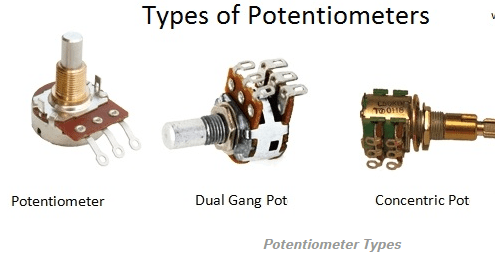Types of Potentiometer

Different types of potentiometers are provided here. This also includes Applications and Uses of potentiometers.
Keep Reading …
What is potentiometer?
“A potentiometer is a very simple instrument which can measure and compare potential differences accurately”. Potential difference is usually measured by an instrument called a voltmeter. The voltmeter is connected across the two points in circuits between which potential difference is to be measured.
It is necessary that the resistance of the voltmeter be large compared to the circuit resistance across which the voltmeter is connected. Otherwise, an appreciable current will flow through the voltmeter which will alter the circuit current and the potential difference to be measured.
Thus the voltmeter can read the correct potential difference only when it does not draw any current from the circuit across which it is connected. An ideal voltmeter would have infinite resistance.
However, there are some potential measuring instruments such as digital voltmeter and cathode-ray oscilloscope which practically do not draw any current from the circuit because of their large resistance and are thus very accurate potential measuring instruments. But these instruments are very expensive and are difficult to use. A very simple instrument that can measure and compare potential differences accurately is a potentiometer.
A potentiometer consists of a resistor R in the form of a wire in which a terminal C can slide.
The resistance between A and C can be varied from 0 to R as the sliding contact C is moved from A to B. If a battery of emf E is connected across R as shown in the figure below:
The current flowing through it is I=E/R.If we represent the resistance between A and C by r, the potential drop between these points will be:
rI=rE/R
Thus as C is moved from A to B, r varies from o to R and the potential drop between A and C changes from 0 to E. Such an arrangement also known as a potential divider can be used to measure the unknown emf of a source by using the circuit given below:
Here R is in the form of a straight wire of uniform area of cross-section. A source of potential, say a cell whose emf Ex is to be measured, is connected between A and the sliding contact C through a galvanometer G.It should be noted that the positive terminal of Ex and that of the potential divider are connected to the same point A.
If in the loop AGCA, the point C and the negative terminal of Ex are at the same potential then the two terminals of the galvanometer will be at the same potential and no current will flow through the galvanometer.
Therefore, to measure the potential Ex, the position of C is so adjusted that the galvanometer shows no deflection. Under this condition, the emf Ex of the cell is equal to the potential difference between A and C whose value Er/R is known. In the case of a wire of uniform cross-section, the resistance is proportional to the length of the wire. Therefore, the unknown emf is also given by:
Ex=E r/R
Ex =E l/L
Where L is the total length of the wire AB and l is its length from A to C , after C has been adjusted for no deflection. As the maximum potential that can be obtained between A and C is E, the unknown emf Ex is determined when no current is drawn from it and therefore, the potentiometer is one of the most accurate methods for measuring potential.
The method for measuring the emf of a cell as described above can be used to compare the emf E1 and E2 of two cells. The balancing lengths l1 and l2 are found separately for the two cells. Then,
E1=E l1/L
and
Ex=E l2/l
Dividing these two equations,we get
E1/E2 = l1/l2
So the ratio of the EMFs is equal to the ratio of the balancing lengths.
See Also: Potentiometer Vs Volteter
Applications of potentiometer:
Photometers are commonly used as control devices in amplifiers, TV sets, and various types of meters. Typical applications include volume and tone controls, balance controls, linearity and brightness control in TV receivers, etc.
To clear more your concepts about potentiometer watch the video:
“I have been exploring for a little bit for any high quality articles or blog posts on this kind of area. Exploring in Yahoo I at last stumbled upon this website. Reading this info So i am happy to convey that I have an incredibly good uncanny feeling I discovered exactly what I needed. I most certainly will make certain to do not forget this site and give it a glance on a constant basis.”
When do we use this formula – E1/E2 = L2+L1/L2-L1 ??
Hi, I do think this is an excellent site. I stumbledupon it ;) I’m going to
revisit once again since i have book-marked it. Money and freedom is the greatest way
to change, may you be rich and continue to guide
others.
I think this is a real great blog post.Thanks Again. Want more.